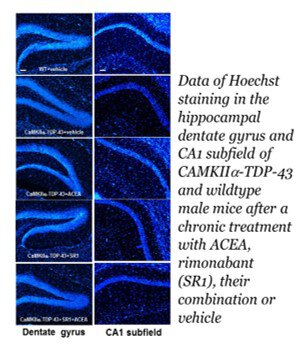Gonzalo-Consuegra C, Santos-García I, García Toscano L, Martín-Baquero R, Rodríguez-Cueto C...de Lago E and Fernández-Ruiz J. Involvement of CB1 and CB2 receptors in neuroprotective effects of cannabinoids in experimental TDP-43 related frontotemporal dementia using male mice
Biomed Pharmacother. 2024
"This study demonstrates the therapeutic relevance of targeting the CB1 and CB2 receptor in FTD".- Javier Fernández-Ruiz
Summary:
Background: The elevation of endocannabinoid levels through inhibiting their degradation afforded neuroprotection in CaMKIIα-TDP-43 mice, a conditional transgenic model of frontotemporal dementia. However, which cannabinoid receptors are mediating these benefits is still pending to be elucidated.
Methods: We have investigated the involvement of the CB1 and the CB2 receptor using chronic treatments with selective ligands in CaMKIIα-TDP-43 mice, analysis of their cognitive deterioration with the Novel Object Recognition test, and immunostaining for neuronal and glial markers in two areas of interest in frontotemporal dementia.
Results: Our results confirmed the therapeutic value of activating either the CB1 or the CB2 receptor, with improvements in the animal performance in the Novel Object Recognition test, preservation of pyramidal neurons, in particular in the medial prefrontal cortex, and attenuation of glial reactivity, in particular in the hippocampus. In addition, the activation of both CB1 and CB2 receptors reduced the elevated levels of TDP-43 in the medial prefrontal cortex of CaMKIIα-TDP-43 mice, an effect exerted by mechanisms that are currently under investigation.
Conclusions: These data reinforce the notion that the activation of CB1 and CB2 receptors may represent a promising therapy against TDP-43-induced neuropathology in frontotemporal dementia. Future studies will have to confirm these benefits, in particular with one of the selective CB2 agonists used here, which has been thoroughly characterized for clinical development.
Why do you highlight this publication?
In a previously published article (Santos-García et al., J. Neuroinflammation 2023), using the same experimental model of FTD used here, we demonstrated the occurrence of an endocannabinoid dysregulation and how such dysregulation may be corrected by elevating the levels of endocannabinoids with an inhibitor of their inactivation mechanism. Now, we demonstrate that, in these conditions, endocannabinoids may serve as an endogenous protective response by activating both CB1 and CB2 receptors, which may serve as novel therapeutic targets in this disease. We also provided the first evidence that part of these effects are caused by reduction in the levels of TDP-43, the protein whose dysregulation elicits the pathology in this FTD subtype.
Publication commented by:
Dr. Javier Fernández-Ruiz
Senior Scientist at Department of Biochemistry and Molecular Biology, Faculty of Medicine, Complutense University. NEURODEGENERATIVE DISEASES: THERAPY DEVELOPMENT - IRYCIS



